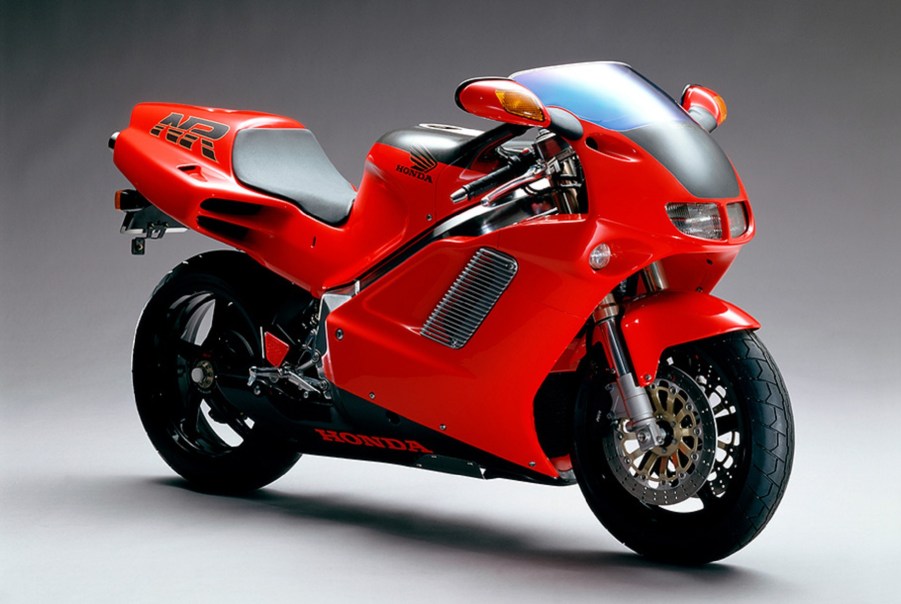
The 1992 Honda NR750 RC40 Is Still a Ground-Breaking Exotic
Once in a great while, the stars align, and bike companies bring their racing technology and engineering to the street. But some motorcycles command outsized legends even amongst this rarified crowd. Honda has a history of releasing bikes like these, from the RC30 to the original Fireblade. And then there’s the motorcycle whose design still wows after almost three decades: the Honda NR750.
Honda put racing tech on the road in what Mecum calls “the most exotic and expensive motorcycle in the world:” the NR750

| 1992 Honda NR750 ‘RC40’ | |
| Engine | 747cc liquid-cooled fuel-injected V4 |
| Horsepower | 125 hp |
| Torque | 50 lb-ft |
| Transmission | Six-speed manual with a slipper clutch |
| Front suspension and travel | 45mm fully-adjustable Showa inverted fork; 4.7” |
| Rear suspension and travel | Fully-adjustable Showa mono-shock; 4.7″ |
| Seat height | 30.7″ |
| Curb weight | 538 lbs |
| Original price | $60,000 |
Manufacturers bringing technology from the racetrack to production street bikes is nothing new. It’s how Ducati’s desmodromic valves became a brand hallmark, for example. But few motorcycles demonstrate a dedication to democratizing motorsports engineering quite like the Honda NR, aka the NR750.
Let’s start with the engine. From the 1970s to the early 1990s, MotoGP was ruled by two-stroke bikes. But while two-stroke engines are powerful for their size, Soichiro Honda hated them. Thus, Honda’s racing team stuck with four-stroke designs.
However, while Honda really needed eight cylinders to beat the two-strokes, contemporary rules limited teams to four-cylinder designs, Mecum explains. So, Honda combined two circular pistons into a single oval-shaped one. That’s right, the Honda NR750 has oval pistons.

Technically, the 1979 NR500 race bike had oval pistons first. But the Honda NR750 has plenty more firsts—and patents—to its name. It’s the first Japanese fuel-injected production motorcycle and the first production bike period with inverted forks, side-mounted radiators, and magnesium wheels. The NR750 also introduced under-seat exhausts to the four-stroke world—and, in other first, they’re stainless steel.
Like the earlier RC30, the Honda NR750 has a single-sided swingarm and titanium connecting rods. But rather than carbon-Kevlar bodywork, the NR has carbon-fiberglass panels—another first. Also, its non-reflective windshield is titanium-coated to reduce glare and reflections. And it shades the NR750’s digital display.
30 years later, the Honda NR750 still feels like an extremely special superbike

These days, carbon-fiber body panels, titanium components, and inverted forks are common sights on high-end motorcycles. But in 1992, this was space-age stuff. As a result, despite its age, the Honda NR750 feels surprisingly modern. It looks modern, too. And those looks, particularly the exhaust and swingarm, notably inspired Massimo Tamburini’s iconic Ducati 916 design.
Yet the Honda NR750 doesn’t look exotic and modern. That oval-piston V4 redlines at 15,000 RPM, making smooth, seamless, and effortless power all the way, MCN reports. The Showa suspension is compliant but doesn’t compromise feedback, and its brakes are modern-level strong. And while it’s a bit heavy and not quite as sharp as the RC30, it’s still “extremely satisfying to ride,” MCN says. Not to mention “still wickedly fast,” Mecum adds.
Unfortunately for Honda and the NR, later rule changes prevented manufacturers from running oval pistons. But while that tech is essentially a dead end, the NR750’s design continues to shape modern sportbikes and superbikes. It’s no longer cutting-edge, strictly speaking, but only because it helped set that edge in the first place.
With a hand-built exotic design comes an exotic price tag
Owing to its exotic engineering and hand-built nature, the Honda NR750 was an expensive motorcycle. It’s also exceedingly rare, even more so than the RC30 and modern race replicas like the Desmosedici RR. While the exact number varies between sources, the consensus is that Honda built about 300 NRs.
This rarity, combined with its tech and status, makes for a six-figure price tag. As of this writing, the cheapest example sold at a Mecum auction went for $101,750 in 2020. And a year earlier, another NR sold for $181,500.
But then, even when it was new, the NR750 wasn’t cheap. So, it’s not necessarily surprising that it still sells like an exotic.
Follow more updates from MotorBiscuit on our Facebook page.


